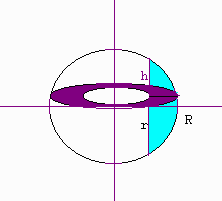1.6: The Volume of Cored Sphere
- Page ID
- 36009
Let \(S\) be a sphere of radius \(R\), center at the origin and let \(C\) be a cylinder of radius \(r\) (\(r < R\)) with the z-axis the axis of rotation. We are concerned with the volume of the part of \(S\) outside \(C\). This cored sphere can also be realized by taking the region bounded by the circle
\[ x^2 + y^2 = R^2 \]
and the line
\[ x = r \]
and revolving it around the \(y\)-axis. Taking a cross-section perpendicular to the y-axis and revolving it around the y-axis produces a washer. The inner radius of the washer is \(r\) and the square of the outer radius of the washer is
\[ R^2 - y^2\]
Let h be the the height of the region (from the x-axis).
\[ h = R^2 - r^2\]
Hence the area of the washer is
\[ Area = p[(R^2 - y^2 ) - r^2] = p[(R^2 - r^2 ) - y^2] = p[h^2 - y^2]\]
The smallest \(y\) value the cross-section will have is \(-h\) and the largest is \(h\).
We can write this as an integral
\[\begin{align*} \pi \int_{-h}^{h}\left(h^{2}-y^{2}\right) dy &=\pi\left(h^{2} y-\frac{1}{3} y^{3}\right]_{-h}^{h} \\[4pt] &=\pi\left[\left(h^{3}-\frac{1}{3} h^{3}\right)-\left((-h)^{3}-\frac{1}{3}(-h)^{3}\right)\right] \\[4pt] &=\frac{4}{3} \pi h^{3} \end{align*}\]

Notice that the volume only depends on the height of the region.

